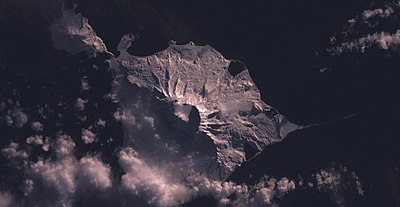| Revision as of 17:38, 17 February 2016 editVipinhari (talk | contribs)Autopatrolled, Extended confirmed users, Pending changes reviewers, Rollbackers19,498 editsm Reverted edits by 216.25.187.122 (talk) (HG) (3.1.19)← Previous edit | Revision as of 06:47, 23 May 2016 edit undoOzzieboy (talk | contribs)Extended confirmed users10,349 edits Add exception + external linkTag: Visual editNext edit → | ||
| Line 2: | Line 2: | ||
| ], from ] ]]] | ], from ] ]]] | ||
| '''Big Ben''' is a ] ] that dominates the geography of ] in the southern ]. It is a composite cone with a diameter of approximately 25 kilometres. Its highest peak is ], which is 2,745 m ]. Much of it is covered by ice, including 14 major ]s which descend from Big Ben to the sea. Big Ben is the highest mountain in Australian Territory. A smaller volcanic headland, the ], extends approximately 10 km to the northwest, created by a separate volcano, ]; its highest point is ], at 715 m. | '''Big Ben''' is a ] ] that dominates the geography of ] in the southern ]. It is a composite cone with a diameter of approximately 25 kilometres. Its highest peak is ], which is 2,745 m ]. Much of it is covered by ice, including 14 major ]s which descend from Big Ben to the sea. Big Ben is the highest mountain in Australian Territory, except for those in the ]<ref>{{Cite web|url=http://heardisland.antarctica.gov.au/about/frequently-asked-questions|title=Frequently asked questions|last=Division|first=c=AU;o=Commonwealth of Australia;ou=Department of the Environment;ou=Australian Antarctic|website=heardisland.antarctica.gov.au|language=en-AU|access-date=2016-05-23}}</ref> A smaller volcanic headland, the ], extends approximately 10 km to the northwest, created by a separate volcano, ]; its highest point is ], at 715 m. | ||
| ==Volcanic activity== | ==Volcanic activity== | ||
Revision as of 06:47, 23 May 2016


Big Ben is a volcanic massif that dominates the geography of Heard Island in the southern Indian Ocean. It is a composite cone with a diameter of approximately 25 kilometres. Its highest peak is Mawson Peak, which is 2,745 m above sea level. Much of it is covered by ice, including 14 major glaciers which descend from Big Ben to the sea. Big Ben is the highest mountain in Australian Territory, except for those in the Australian Antarctic Territory. A smaller volcanic headland, the Laurens Peninsula, extends approximately 10 km to the northwest, created by a separate volcano, Mount Dixon; its highest point is Anzac Peak, at 715 m.
Volcanic activity
Volcanic activity at the cone has been known since 1881. An eruption occurred in 1993. Satellite images detected eruptions during 2000. On 2 February 2001, observations from Atlas Cove, 15 km NW of Mawson Peak, showed plumes up to 1 km high over the volcano. Satellite images showed hotspots at various times from 2003 to 2008, and during September 2012. A further eruption was reported on 2 February 2016, and was recorded by scientists who happened to be in the area on an expedition.
See also
References
- Division, c=AU;o=Commonwealth of Australia;ou=Department of the Environment;ou=Australian Antarctic. "Frequently asked questions". heardisland.antarctica.gov.au. Retrieved 2016-05-23.
{{cite web}}: CS1 maint: multiple names: authors list (link) - Big Ben
- Heard Island Volcano - John Seach
- "Scientists film Big Ben sub-Antarctic volcano eruption". BBC News. Retrieved 2016-02-02.
- LeMasurier, W. E.; Thomson, J. W., eds. (1990). Volcanoes of the Antarctic Plate and Southern Oceans. American Geophysical Union. p. 512 pp. ISBN 0-87590-172-7.
External links
- Click here to see a map of Heard Island and McDonald Islands, including all major topographical features
- Location and history of Heard Island
- Australian Government (Department of Sustainability, Environment, Water, Population and Communities) Heard Island and MacDonald Islands (HIMI) website
53°06′30″S 73°31′30″E / 53.10833°S 73.52500°E / -53.10833; 73.52500
This subantarctic islands location article is a stub. You can help Misplaced Pages by expanding it. |